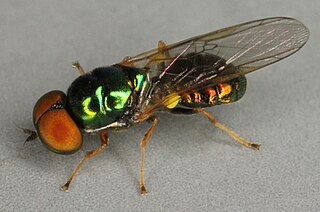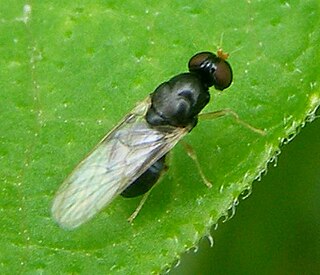
Oplodontha viridula, the common green colonel, is a European species of soldier fly.

Sargus iridatus, the iridescent centurion, is a European species of soldier fly.

Sargus bipunctatus, the twin-spot centurion, is a European species of soldier fly.

Sargus cuprarius, the clouded centurion, is a European species of soldier fly.

Microchrysa flavicornis, the green gem, is a European species of soldier fly.

Pachygaster leachii, the yellow-legged black, is a European species of soldier fly.

Oxycera morrisii, the white-barred soldier, is a European species of soldier fly.

Beris vallata, the orange legionnaire or common orange legionnaire, is a European species of soldier fly.

Beris clavipes, the scarce orange legionnaire, is a European species of soldier fly.

Beris geniculata, the long-horned black legionnaire, is a European species of soldier fly.

Beris morrisii, the yellow-legged black legionnaire, is a European species of soldier fly.

Dialineura anilis is a species of ' stiletto flies' belonging to the family Therevidae. It is a Palearctic species with a limited distribution in Europe

Brachyopa flavescens, The Yellow Sapeater, is a fairly common species of syrphid fly. It has been observed in northeastern North America. Hoverflies get their names from the ability to remain nearly motionless while in flight. The adults are also known as flower flies for they are commonly found around and on flowers, from which they get both energy-giving nectar and protein-rich pollen. Larvae for this genus are of the rat-tailed type. B.flavescens larvae have not been described.

Arctosyrphus willingii, the northern longbeak, is a species of rat-tail maggot fly in the family Syrphidae. This species was formerly a member of the genus Lejops.

Brachyopa daeckei, the black-tailed sapeater, is a rare species of syrphid fly that has been observed in northeastern North America. Hoverflies get their names from the ability to remain nearly motionless while in flight. The adults are also known as flower flies for they are commonly found around and on flowers, from which they get both energy-giving nectar and protein-rich pollen. Larvae for this genus are of the rat-tailed type. B.daeckei larvae have not been described.

Blera robusta, the Greenish Wood Fly, is a rare species of syrphid fly first officially described by Curran in 1922. Hoverflies get this name from the ability to remain nearly motionless while in flight. The adults are also known as flower flies, for they are commonly found around and on the flowers from which they get both energy-giving nectar and protein rich pollen. The larvae are of the rat-tailed type, feeding on exuding sap or in the rot holes of trees.
Blera analis, the Orange-tailed wood fly, is an uncommon species of syrphid fly first officially described by Macquart, 1842. Hoverflies get their names from the ability to remain nearly motionless while in flight. The adults are also known as flower flies for they are commonly found around and on flowers from which they get both energy-giving nectar and protein-rich pollen. The larvae are of the rat-tailed type feeding on exuding sap or in the rot holes of trees.
'Blera metcalfi , Metcalf's wood fly, is a rare species of syrphid fly first officially described by Curran in 1925 Hoverflies get their name from the ability to remain nearly motionless while in flight. The adults are also known as flower flies for they are commonly found around and on flowers from which they get both energy-giving nectar and protein rich pollen. The larvae are of the rat-tailed type feeding on exuding sap or in the rot holes of trees.

Sphiximorpha willistoni, or Williston's wasp fly, is a rare species of syrphid fly found in eastern North America. It is a strong wasp mimic. Hoverflies can remain nearly motionless in flight. The adults are also known as flower flies for they are commonly found on flowers, from which they get both energy-giving nectar and protein-rich pollen. Larvae in this genus are found in sap runs of trees.

Chrysotoxum baphyrum is a species of holarctic hoverfly. The adults are strong mimics of wasps. Larvae of this genera, when known, are aphid predators.


















